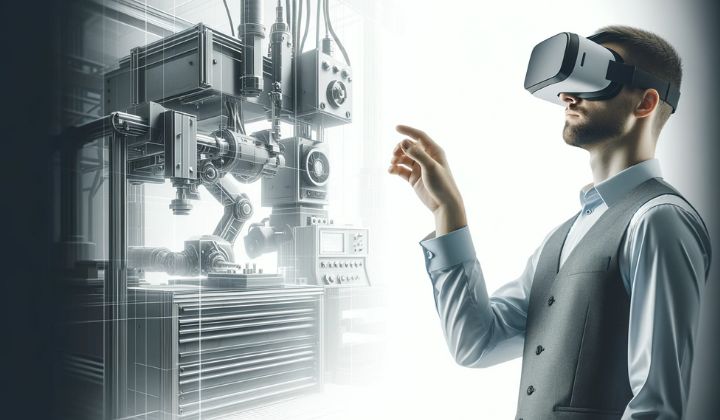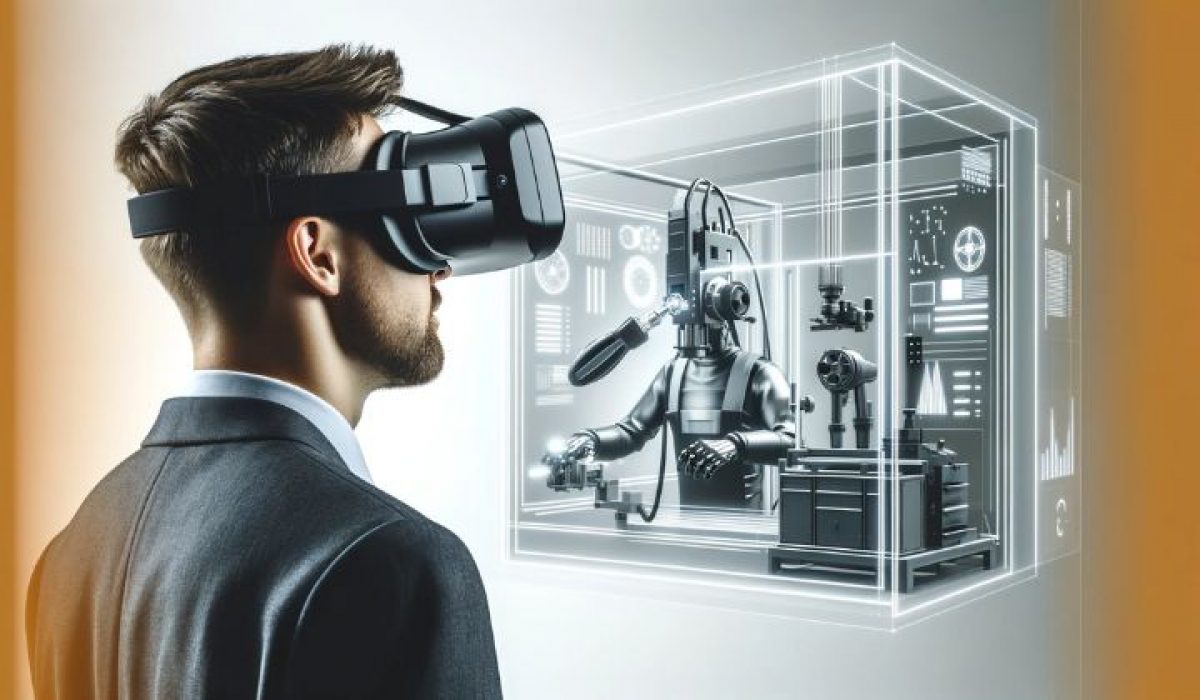A wide range of industries, including gaming and entertainment, as well as a number of other sectors, make substantial advantages of AR/VR. Using the richness of 3D and the Internet of Things, we are able to develop appealing augmented reality experiences that contribute to the improvement of efficiencies, the construction of better products, and the creation of an environment that is safer and more productive for both workers and customers. The manufacturers will make full use of AR Development Company in a variety of different areas of the manufacturing business.
Analytics Insight predicts that AR/VR in the manufacturing industry to touch US $2.8 Billion in 2023.
Using augmented reality and virtual reality technology in the manufacturing business helps to identify and eliminate risks, as well as operational procedures, design, and employee training. Additionally, it helps to boost employee safety by lowering the number of accidents that occur.
Do you Know? How Much Does VR App Development Cost?
First things first: let’s dive into the post by learning about some of the and advantages of augmented reality and virtual reality in manufacturing industry.
Top Advantages of Augmented Reality/Virtual Reality in Manufacturing

The advantages of AR/VR in manufacturing industry comes with a number of inherent advantages, some of which are listed below.
1.Production
Irrespective of whether we are producing toys or jet engines, each and every product must adhere to a predetermined set of assembly instructions. In order to manufacture something, it is necessary to join together hundreds or thousands of components in a specific order as quickly as possible.
As an instance, assembly help in the aerospace production process includes the utilization of projectors to demonstrate the subsequent positioning of the part. Size, adaptability, and capacity are the primary factors that differentiate augmented reality from other technologies today.
VR Game Development Cost: Is It Worth the Investment?
2. The process of designing and prototyping
At this early stage, virtual reality (VR) has the capability to truly display how a product might appear without the need to create a physical prototype. Ford Motors has been employing its proprietary FIVE (Ford Immersive Vehicle Environment) virtual reality technology in the automotive sector for a considerable amount of time, much before consumer Oculus and HTC headsets were available on the market. This technology allows Ford Motors to develop virtual representations of automobiles that do not yet exist through the use of the most minute details.
The designs are then transferred into virtual automotive environments, which gives engineers the opportunity to experience what it will be like to be inside the subsequent automobile.
- Decrease the amount of time spent on product design and evaluation.
- The environment is convenient for multiple designers to interact with one another within the project.
- The capability to give producers and customers with detailed product designs; this includes both parties.
- Product quality that has been improved through manufacturing.
How much Does It Cost To Create Metaverse?
3. Visualisation of Equipment
Engineers and technicians can gain a more comprehensive understanding of how manufacturing equipment operates and identify areas for improvement by utilizing the detailed visualization capabilities of AR and VR. Engineers can identify potential issues with equipment placement or productivity, for instance, by simulating a manufacturing process using VR.
What is Fintech App Development Cost?
4. Improved Technical Support
Technical support is another important component of the manufacturing industry. Customers want their equipment manufacturers to provide prompt and effective assistance, preferably on-site. On-site assistance can be time-consuming and costly. Remote manufacturers may find it difficult to react to client requests swiftly. Here, augmented reality (AR) plays an important part in communication, as technical specialists and engineers are connected remotely to examine the product. This will almost certainly aid in the resolution of the issues without the need for a visit to the actual location.
How Much Does It Cost To Build a Web3 Game?
5. An enhanced experience for the customer
When it comes to the design and manufacturing of products, augmented reality and virtual reality can also be used to improve the customer experience. Through the use of augmented reality and virtual reality, businesses are able to build immersive experiences that enable customers to preview and engage with products before they are ever manufactured. Customers may obtain a better grasp of what they are ordering before they commit to making a purchase, which helps to lessen the risk of they being dissatisfied with the product or service they have purchased.
Cost Breakdown for AR App Development
6. Inventory Management
Selecting an item from a shelf in a warehouse still requires human intervention, even if AI algorithms can simplify the intricate process of monitoring inventory databases. Augmented reality technology streamlines the procedure, making it more accurate and efficient.
Warehouse employees can receive precise item placement instructions and be led to the exact aisle and shelf where the item is kept using iPads, Microsoft HoloLens, or any other kind of headset. This approach is invaluable, as any anyone who has ever set foot in an industrial warehouse can tell you.
How Much Does It Cost to Develop an NFT Marketplace?
7. Simplify the complicated assembly procedure
Conveyor belts are frequently utilised in manufacturing units at different stages of the manufacturing process.
AR can play a big part in explaining the procedure that is performed in each stage while training new recruits.
AR allows you to provide detailed step-by-step assembly instructions as well as remote mentoring, which can help enhance productivity and decrease unnecessary errors.
The video shot with AR technology will provide a better understanding of the task that the technician will have to undertake on the shop floor.
An AR device can give step-by-step instructions, allowing the assembly process to run faster and respond with the most up-to-date information.
7 Top Tips on Turning Your Passion for Career in Gaming
8. Cut costs
AR will be used to develop solutions in the manufacturing sector that will cut recruitment expenses, training costs, infrastructure costs, and a variety of other expenditures.
Employees can be physically positioned in another location and deliver solutions from a distance using data stored in the cloud and the space produced by AR and VR.
Engineers that employ AR and VR intensively have already created TVs and multimedia systems.
The electronics manufacturing sector will flourish in the coming decades as numerous gadgets will be built employing AR and VR.
AR delivers unprecedented transparency into processes, and linked IoT data enables quick problem resolution and allows you to solve issues before they arise.
9. Enhanced Safety and Increased Collaboration
There is also the possibility of using AR and VR to improve the safety of the manufacturing process. The use of virtual reality (VR) to imitate hazardous conditions allows for the training and testing of employees to take place in a risk-free setting. The likelihood of accidents and injuries occurring in the workplace is decreased as a result of this.
During the production process, augmented reality and virtual reality can be utilised to improve departmental collaboration. It is possible for teams to work together in a virtual environment through the utilisation of virtual reality (VR), which enables them to more successfully brainstorm, cooperate, and solve problems. The time it takes to finish the production process is cut down as a result of this, and it also makes it possible for departments to communicate more effectively with one another.
How Much Does It Cost to Build a Dating App? A Comprehensive Guide
Final Thoughts
In the process of industrial manufacturing, advantages of AR/VR have the potential to be utilised to a substantial degree. It is possible to simplify and speed up the manufacturing process by utilising this technology in the most convenient way possible. They provide assistance to the processes of designing and producing in their many forms. Increasing the use of augmented and virtual reality in the manufacturing industry has the potential to boost both the company’s revenue and its profits. Augmented reality and virtual reality have the potential to completely transform the manufacturing industry.




Pingback: How To Respond to Technological Change 2024
Pingback: Do You Know? The Benefits of Cloud Computing for Small Businesses
Pingback: IoT in Healthcare: Applications, Benefits, Challenges, And Future 2024
Pingback: Top AR & VR Trends to Transform E-commerce 2024
Pingback: The Impact of IoT on Business Efficiency 2024
Pingback: Top 10 Benefits of Church Management Software
Pingback: 10 Best AR Apps for Classrooms Using Apple’s New ARKit